Una
| Author:Laxman Burdak, IFS (R) |
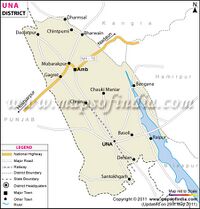
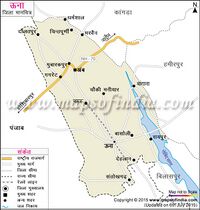
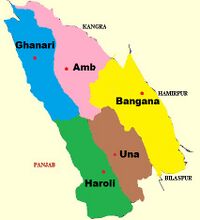
Una (ऊना) is a city and district in Himachal Pradesh.
Location
It is situated in the Punjab region of India. Una is located at 31.48°N 76.28°E. It has an average elevation of 369 metres. Una district shares its border with the Hoshiarpur District and ropar district of Punjab. The terrain is generally a plain with low hills. Una has been identified as a main industrial hub and has become a transit town for travellers going to the famous city of Dharamshala or locations within the Himalayas such as Kullu, Manali, Jawalamukhi, and Chintpurni.
Tahsils
Una has five tehsils, namely Bharwain, Haroli, Amb, Bangana and Una.
Source - https://www.census2011.co.in/data/district/235-una-himachal-pradesh.html
Villages in Una tahsil
Cities: 1 Una, 2 Santokhgarh, 3 Mehatpur Basdehra,
Villages: 1 Abada Barana, 2 Aerian, 3 Ajauli, 4 Ajnoli, 5 Arjunpura, 6 Arniala, 7 Badehar Nichla, 8 Badehar Upperla, 9 Badehar Urf Dehlan, 10 Badoli, 11 Badsala , 12 Ban Garh, 13 Bans Bounsre, 14 Bareda, 15 Barnoh, 16 Barsara , 17 Basal, 18 Basoli Nichli, 19 Basoli Upperli, 20 Batuhi, 21 Behdala, 22 Bhadsali, 23 Bhadsali Bhul Gharh, 24 Bhadsali Har, 25 Bhadsali Tholian, 26 Bhaini Khad , 27 Bhaloh, 28 Bhalola, 29 Bharolian Kalan, 30 Bhatoli College, 31 Bhatoli Nichli, 32 Bhatoli Upperli, 33 Bhrolian Khurd, 34 Binnewal, 35 Chak Khad, 36 Chalola-I, 37 Chalola-II, 38 Charatgarh Nichla, 39 Charatgarh Upperla, 40 Chatara Upperla, 41 Chatra Khas, 42 Chaukhyal, 43 Chhatarpur, 44 Chhatarpur Dhada, 45 Dangehra, 46 Dangoli, 47 Daulatpur, 48 Dehlan Uperli, 49 Dhadial, 50 Dhamandri, 51 Dhariyan Wala, 52 Dhatwara, 53 Fatehpur, 54 Fatehwal, 55 Galua, 56 Ghalu Wal, 57 Ghandawal, 58 Ispur, 59 Ispur Tanda, 60 Ispur Upperla, 61 Jakhera, 62 Jal Graon, 63 Jangal Bhadsali, 64 Jangal Khad, 65 Jangal Panjawar, 66 Jankaur Har, 67 Jankaur Khas, 68 Jarai Mehatpur, 69 Jhalera , 70 Jhambar, 71 Jhorowal, 72 Kalsera, 73 Kasba, 74 Khad Khas, 75 Khadunni, 76 Khanpur, 77 Kotla Kalan Nichla, 78 Kotla Kalan Upperla, 79 Kotla Khurd, 80 Kuriala, 81 Kuthar Kalan, 82 Kuthar Khurd, 83 Lal Singhi, 84 Lam, 85 Lamian, 86 Lamlehra, 87 Lamlehri Nichli, 88 Lamlehri Upperli, 89 Lawana Majra, 90 Madan Pur, 91 Mahanta, 92 Majara, 93 Majhlian, 94 Malahat, 95 Malukpur, 96 Nagnoli, 97 Nagnuli Har, 98 Nangal- I, 99 Nangal-II, 100 Nangran Nichla, 101 Nangran Upperla, 102 Nari Nichli, 103 Nari Upperli, 104 Pandogha Kairian, 105 Pandogha Khas, 106 Pandogha Nichla, 107 Pandogha Uparla, 108 Panjawar, 109 Panjawar Nichla, 110 Panoh-I, 111 Panoh-II, 112 Pekhu Bela, 113 Puna, 114 Raipur Nichla, 115 Raipur Upperla, 116 Raisari Nichli, 117 Raisari Upperli, 118 Rakkar Kaloni, 119 Ram Nagar, 120 Rampur, 121 Rampur Bela, 122 Salangari, 123 Saloh Nichla, 124 Saloh Uperla, 125 Samoor Kalan Awal, 126 Samoor Kalan Doam, 127 Sanjhot, 128 Sanoli, 129 Sansala Nagar, 130 Sasan, 131 Satletta, 132 Sunehra, 133 Surjehra, 134 Tabba, 135 Thakar Dawara, 136 Tiuri-Doam, 137 Tiuri-I, 138 Udheypur, 139 Vishna Nagar,
Source - https://www.census2011.co.in/data/subdistrict/150-una-una-himachal-pradesh.html
Geography
Una lies in the southwestern part of Himachal Pradesh, with the beautiful Sivalik hills of the Himalayas gently rolling on one side. The Satluj river passes alongside Shahtalai hills, known for the shrine of Baba Balak Nath.
Una is geograhically one of the most apt and versatile area of Himachal Pradesh with close vicinity to Chandigarh connected by broad gauge railway and four lane express highway.
Jat clans
Una district has about: 20,000 Jats. Jat clans found in Una district are:
Himachal Jat Kalyan Parishad
Himachal Jat Kalyan Parishad (Regd.) is a registered organization working for the welfare of Jats.
Address: Village Valiwal (Heeran), Post Office Palkowah, Tehsil Haroli, District Una, Himachal Pradesh
Executive body: State president :- Mr. Ishwar Singh Mann
Contact details:
- Mobile No. 09814212563, 09814611563, 09625486744
- E-Mail:- is.mann@yahoo.com
Jat villages
हिमाचल के ऊना जिले में जाटों की आबादी 20 हजार से ज्यादा है। प्रदेश के किसी जिले से यह प्रदेश में सबसे ज्यादा आंकड़ा है। इसी तरह कांगड़ा जिले में जाटों की संख्या 12 हजार से ज्यादा है। इसके अलावा चंबा, हमीरपुर, सोलन, सिरमौर, कुल्लू और शिमला आदि के कई हिस्सों में जाट समुदाय के लोग हैं। [1]
- Bangana tahsil: Jateheri, Kukhera Jatan, Rajli Jatan
History
Una is home to the Kila, which is a historical fort and an ancestral home of the descendants of the first guru of the Sikhs, Guru Nanak.
H.A. Rose[2] writes that Dod (दोद), is a Rajput tribe found in Hoshiarpur. The Dods are almost entirely confined to the Bit tract in the Siwaliks, their head being the Rana of Manaswal. The Dods are Jadav or Chandrabansi by origin......
Four leaders of the tribe migrated from Udaipur to Garh Mandāl,1100 years ago, and thence to Garh Muktasar. Thence Jodh Chand seized Manaswal, expelling Hira, the Mahton leader, whose tribe held the tract, 40 generations ago. Rana Chacho Chand, the 19th Rana, was attacked by the Katoch ruler, but his brother Tilok Singh (Tillo) defeated him at Mahudpur in Una, and Tillo's shrine at Bhawani is reverenced to this day. In Sambat 1741 Rana Jog Chand repelled a Jaswal invasion. Rana Bakht Chand annexed Bhalan, with 12 dependent villages, in Una. His successor, Ratn Chand, repelled a Jaswal army under
[Page-244]: Bhagwan Singh Sonkhla who was killed, and in his memory a shrine at Kharali was erected. A treaty now defined the Jaswal and Dod territories. Under Mian Gulab Singh regent during Achal Chand's minority, Nadir Shah is said to have visited the tract and ordered a massacre of the Rasali people, but the Rana obtained from him a grant of Bathri, then a Jaswal village. Rana Jhagar Chand, however, espoused the Jaswals' cause, when they were attacked by Sansar Chand of Kangra in 1804 A.D., and repulsed him. On Ranjit Singh's invasion of the Manaswal plateau, the Rana was confirmed in his possessions, subject to a contingent of 15 horse. The rule of inheritance was primogeniture, mitigated by a system of lopping off villages as fiefs for younger sons, many of whose descendants still hold villages, thus reducing the size of the estate.
Pre-Independence History
Jaswal State
It is believed that the present Una district, minus its Eastern side, was formally a part of the erstwhile Kangra State. Bulk of the present Una district which is otherwise popularly known as Jaswan Dun was ruled by the Katoch family of Kangra. The Jaswan State which occupied a fertile tract in the Jaswan Dun valley of the outer hills of the historical Kangra state was founded by a cadet of the Katoch line about A.D.1170, whose name is said to have been Purab Chand. Jaswan was the first off shoot from the parent stem. It is not improbable, however, that the State was originally a fief (Jagir) which became independent in the unsettled times following on the Muhammadan invasions. From Purab Chand to Ummed Singh 27 Rajas in all ruled the Jaswan State. Not much is known about the Jaswan State until the time of Akbar when it became subject to Mughal rule. But for one or two unsuccessful rebellion it remained loyal to the Mughal empire and assisted the Mughals with contingents as and when required. But with the decline of the Mughal empire and rise of the Jat Sikhs, the Jaswan state came under their dominance and in 1786 Raja Sansar Chand of Kangra acquired paramount power in the hills. So heavy was his hand even upon the off shoots of his own family that they combined against him-Jaswan among them-when the Gurkhas invaded Kangra under Amar Singh Thapa.
With the acquisition of Kangra Fort, on the expulsion of the Gurkhas in 1809, Jaswan State became subject to Ranjit Singh of Punjab and in 1815 it was annexed to the Sikh Kingdom. It was in the autumn of that year Maharaja Ranjit Singh summoned all his forces, personal and tributary, to assemble at Sialkot, unluckily the Rajas of Nurpur and Jaswan failed to obey the summons and a fine fixed beyond their resources was imposed on each. Submitting quietly to his fate Raja Ummed Singh resigned his State and accepted a Jagir of Rs. 12000 annual value and thus came the end of Jaswan State which lasted for probably 600 years.
Jaswan has yet to meet another challenge and taste another adversity before final extinction. In consequence to the treaty of Lahore of 9th March 1846, Hoshiarpur as a part of Jalandhar Doab had been annexed to the British Territories. The Raja of Jaswan and other princes, judging doubtlessly the liberal treatment the Shimla Hill Chiefs had received at the hands of the British Authorities, were under the belief that with the coming of the English the powers sovereignty formerly enjoyed by them would be restored, though no such hopes had ever been held out of them. But discovering that change of masters had not changed their status, all of them sympathized with the Sikh cause during the second Sikh War of 1848 and as such Raja Ummed Singh joined the revolt of the Hill Chief against British authority. John Lawrence then Commissioner of Hoshiarpur attacked the Raja’s forts and razed them to the ground. His possessions were confiscated and he and his son Jai Singh were deported to Almora in Kumaon (Garhwal) in the North-West provinces, where both of them died. Some time later, at the request of Maharaja Gulab Singh of Jammu, Raja Ran Singh, son of Raja Jai Singh, was permitted to return, in order that his son, Raghunath Singh might marry the Maharaja’s grand-daughter.
In the year 1877, at the request of Maharaja Ranbir Singh of Jammu and Kashmir, the British government restored to Raja Ran Singh the Jagir in Jaswan, originally held by Raja Ummed Singh consisting of 21 villages in Jaswan Dun valley and the family garden at Amb, as well as palace buildings of Raja Ummed Singh at Rajpura. Raja Ran Singh died in 1892 and was succeeded by his son Raja Raghunath Singh who also died in 1918. Thereafter, Laxman Singh succeeded him who started residing at Amb. After expiry of Laxman Singh his son Chani Singh is living at Amb.
But before a description is given of KUTHLEHAR STATE, which was situated on the Eastern side of the present Una district a mention of the principality of Bedi’s of Una, is a must.
The District Gazetteer of Hoshiarpur (1884) reads :- “Bedi Baba Kaladhari, a descendant of Baba Nanak, crossed over from Dera Baba Nanak (Gurdaspur), early in the last century and after wandering about the Jullundur Doab, for some years, finally settled down at Una, Hoshiarpur, where he attracted a crowd of followers who flocked to hear his eloquent disquisition on the Granth Sahib, a book as difficult of understanding then as in the present day. The Jaswal Raja Ram Singh made himself popular by granting the Bedi the revenue of seventy ghumaons of land”. In Samvat 1860 (1804 A.D.) Raja Ummed Singh gave to Baba Sahib Singh Bedi the whole of the Una Taluka, a grant which was confirmed by Maharaja Ranjit Singh in Samvat 1872 and about the same time he received Nurpur Taluka from Sardar Budh Singh. Later on Maharaja Sher Singh gave Talhatti to Baba Bikrama Singh Bedi and thus the principality of Bedi’s of Una went on flourishing and expanding. And as such, after the annexation of the Jullundur Doab by the British in 1846, Baba Bikrama Singh was one of the few powerful Jagirdars left in the area. He held a jagir worth two lakhs of rupees which included more than a dozen villages granted to him by Maharaja Sher Singh and Maharaja Dalip Singh, besides the well fortified and strong forts of Nurpur Bedian, Gunachaur and Dakhni Serai. The announcement of the British Government to collect and melt all the cannons seized from the local chiefs resulted in a clash between Bikrama Singh Bedi and the British. Outright refusal to surrender the guns at any cost led to dismantling of all the forts and melting of the guns/cannons besides confiscating the jagir as punishment and thereby offering a pension of Rs. 31,212 which was further reduced to an insignificant amount of Rs. 12000. After turning down the offer of reduced pension Baba Bikrama Singh Bedi devoted himself whole heartedly in raising an armed revolt against the Britishers in the hills. It was at this time that the hill Raja of Jaswan and Datarpur also revolted thereby converting the entire Jaswan Dun Valley from Hajipur to Rupar into a trouble spot for the British. Baba Bikrama Singh rushed to reinforce the army of Jaswan Raja Ummed Singh, but unfortunately he was defeated, before Bikrama Singh would join him. Left alone after the defeat of hill Rajas Bikrama Singh thought it advisable to join the forces of Sher Singh. After the historic battles of Chillianwala and Gujrat a meeting of the topmost leaders of the insurrection was held at Rawalpindi and in view of the majority decision, of which he was not a party, Baba Bikrama Singh who also surrendered alongwith others, remained in surveillance at Amritsar till his death in 1863. Nowadays, Baba Sarvjot Singh Bedi is on the holy and saintly gaddi.
Kuthlehar State
Situated in the eastern part of the present Una district, as mentioned earlier, Kuthlehar was the smallest of all the Kangra kingdom in olden times. As it consisted of two provinces-Chauki and Kuthlehar, hence the double name by which the State was generally known. The territory of Kuthlehar has been formed by a break in the continuity of the second or Jaswan Chain of the hills. As this ridge approaches the Sutlej, it suddenly divides into two parallel branches; and the valley between them, with a portion of the enclosing hills, is the pretty State of Kuthlehar. The dynasty is one of considerable antiquity. The progenitor of the family was a Brahmin but on acquiring regal he was recognized as Rajput. Mr. G.C. Barnes states that he came from Sambhal, near Moradabad but the family records trace his descent from a Raja of Poona. About the tenth or eleventh century the then head of the family, named Jas Pal, conquered the taluqas of Talhatti and Kuthlehar and fixed his capital at Kot-Kuthlehar. The two small states of Bhajji and koti in the Simla Hills were said to have been founded, by his second son and grand-son. The clan name is Kuthlehria.
Although the state is not mentioned in the Muhammadan histories of the time yet the ruling family possess sanads granted by the Mughal emperors, addressing them as Rai and recognising their rights as rulers of the tracts Chauki, Kuthlehar, Mankhandi in Nadaun and Talhatti in Hoshiarpur on payment of tribute and under the condition of military service. They enjoyed tranquil possession of their territory all through the Mughal period, but in later times the aggressions of the neighbouring States reduced their country to the present limits of the Kuthlehar taluqa .
In the year 1758 Ghamand Chand who was appointed Governor of the hills by Ahmad Shah Durrani, annexed Chauki, the northern province of the state and in 1786, Sansar Chand seized Kuthlehar and the Raja was completely dispossessed, but during the Gurkha invasion all his territory was restored. From 1809 the state was subject to the Sikhs and in 1825 Maharaja Ranjit Singh determined to annex it laid siege to the strong fort of kotwalbah. The defence was conducted by Raja Narain Pal in person and for two long months the sieage made no progress. Ultimately a promise of a jagir of Rs. 10000 was then made, if the fort was surrendered, to which the Raja agreed.
During the first Sikh War, Raja Narain Pal succeeded in expelling the Sikhs from Kotwalbah and later in consideration of his services, he was awarded a life grant of Rs. 10000 in addition to the jagir of like value which was afterwards confirmed to his heirs in perpetuity, subject to a nazrana of Rs. 1188. He was also allowed three-fourths of the forest income within his jagir. Later on one of the head of the family Raja Brij Mohal Pal was the fifth Viceregal Darbari in Kangra District.
The Punjab Gazetteer of the Hoshiarpur District (1883-84) in its Chapter "The people" makes a mention of Chaudharis of Ambota and the Brahmins of Takarla in Talhatti under the sub-head Minor families on page 78 while that of "Babhaur family having eight branches with the title of Rai to the head of each" on page 76-77 under the head leading families besides Ranas of Kungrat who being merely a respectable zamindar was enjoying a sufedposhi allowance of Rs. 180. Similarly a mention of Dadwals of Pirthipur had been made by Charles Francis Massy in his book CHIEFS AND FAMILIES OF NOTE OF PANJAB (1890), which reads as follows:- “ The early history of this family is as interesting from a mythical point of view as that of Rai family of Babhaur. Both go back to Bhum Chand, the heaven born. But they branched away from each other about twenty generation ago, when Gani Chand son of Raja Megh Chand, came down from the higher mountains and founded the kingdom of Guler, near Gopipur Dera, Kangra, just north of the Hoshiarpur boundary line. His possessions passed to his elder son Makamal Chand. The younger, Sri Data, moved south into the present Dasua Tehsil of Hoshiarpur and there established the small Rajput State of Datarpur, which had an existence of many hundred years. The Rulers were practically independent until the beginning of the present century, when Maharaja Ranjit Singh began to interest himself in their affairs. Raja Gobind Chand, grandfather of the present representative, having failed to obey the Maharaja’s summons to attend at Lahore was deprived of his sovereign powers and reduced to the status of a Jagirdar. On his death in 1818, his son Raja Jagat Chand was allowed a jagir grant of Rs. 4600/- and was in the enjoyment of this income when the Doab became British territory in 1846. The Rajput princes of Kangra had been under the impression that the accession of the English would be marked by the restoration to them of all their ancient rights and privileges, of which they had been shorn by the Sikhs and bitter was their disappointment of finding that the new Rulers were by no means inclined to alter the state of affairs which existed on their taking over the country. The revolt of the Jaswan and Datarpur Rajas and its speedy suppression by Sir John Lawrence has been described in another Chapter. Raja Jagat Chand was made prisoner and deported with his eldest son Devi Chand to Almora, in the North-West provinces. They were allowed a maintenance grant of Rs. 3600/- per annum.
Jagat Chand died in 1877. His son Udham Singh lives in Pirthipur, Tehsil Una, Hoshiarpur, and enjoys a pension of Rs. 600 per annum. His step-mother has a similar allowance, and the widow of his brother Man chand also receives a small pension. Mian Devi Chand died in 1883, leaving two sons. The elder, Suram Chand, is a General in the army of the Maharaja of Jammu. The second son, Raghbir Chand, has office under the Raja of Mandi, who is married to his sister. He is in receipt of a pension of Rs. 420/- per annum from the British Government. Both brothers are connected by marriage with the Raja of Sirmur. Mian Udham Singh is married to a cousin of Rai Hira Chand of Babhaur. He is a provincial Darbari of the Hoshiarpur district. The widows of Mian Devi Chand are in receipt of a maintenance allowance of Rs. 180/- per annum.”
Source - http://hpuna.nic.in/history.htm
ऊना
ऊना (Una) भारत के हिमाचल प्रदेश राज्य के ऊना ज़िले में स्थित एक नगर है। यह ज़िले का मुख्यालय भी है। ऊना ज़िला दक्षिण-पश्चिमी भाग में स्थित है। ऊना ज़िला पंजाब के होशियारपुर तथा रूपनगर जिलों के साथ सीमाएं बाटँता है तथा हिमाचल प्रदेश के हमीरपुर, कागँड़ा तथा बिलासपुर के साथ इसकी सीमाएं लगती हैं। 1 सितंबर 1972 को हिमाचल प्रदेश सरकार द्वारा कांगड़ा जिले को तीन जिलों में ऊना, हमीरपुर और कांगड़ा में पुनर्गठित किया गया। ऊना जिले की पाँच तहसीलें हैं - अम्ब , बंगाणा , ऊना , घनारी तथा हरोली। हिमाचल प्रदेश के बाकी जिलों की तरह ऊना जिला के लोग भी कृषि पर ही निर्भर करते हैं तथा कृषि ही सीधा लोगों को रोजगार प्रदान करती है। [3]
पंजाब राज्य के करीबी निकटता होने के कारण ऊना जिले का औद्योगिक क्षेत्र में काफ़ी विकास हुआ है। मेहतपुर, गगरेट, टाहलीवाल और अम्ब क्षेत्र ऊना के मुख्य औद्योगिक केंद्र हैं। 11 जनवरी 1991 को उना को चौड़ी गेज ट्रैक बिछाने के साथ ही रेलवे लाइन के साथ नंगल (पंजाब) से जोड़ दिया गया और जोकि अब बढ़ कर दौलतपुर कस्बे तक पहुँच चुकी है । जिले में पंजाबी, हिंदी, पहाड़ी भाषा सामान्यत बोली जाती है। सर्दियों में तेज ठंड पड़ती है और गर्मियों में पारा 45 डिग्री तक पहुँच जाता है । जुलाई से सितंबर तक मौसम बरसात और नमी भरा रहता है। [4]
उना के प्रसिद्ध स्थानों में डेरा बाबा बड़ भाग सिंह, चिंतपुरी माता मंदिर, डेरा बाबा रुद्रु, जोगी पांगा, धर्मशाला महंत, ध्युन्सर महादेव मंदिर तलमेहरा, शिवबारी मंदिर, गगरेट और मिनी सचिवालय शामिल है।
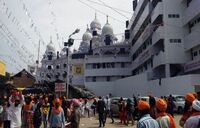
डेरा बाबा वडभाग सिंह: उत्तर भारत का प्रसिद्ध बाबा वडभाग सिंह की तपोस्थली मैड़ी ऊना से 42 किलोमीटर दूर है। इसकी गणना उत्तर भारत के प्रसिद्ध तीर्थस्थलों के रुप में की जाती है। यह पवित्र स्थान सोढी संत बाबा वड़भाग सिंह (1716-1762) की तपोस्थली है। 300 वर्ष पूर्व बाबा राम सिंह के सुपुत्र संत बाबा वड़भाग सिंह करतारपुर पंजाब से आकर यहां बसे थे। कहा जाता है कि अहमद शाह अब्दाली के तेहरवें हमले से क्षुब्ध होकर बाबा जी को मजबूरन करतारपुर छोड़कर पहाड़ों की ओर आना पड़ा था। जब बाबा जी दर्शनी खड्ड के पास पहुंचे तो उन्होंने देखा कि अब्दाली की अफगान फौजें उनका पीछा करते हुए उनके काफी नजदीक आ गई हैं। इस पर बाबा जी ने आध्यात्मिक शक्ति से खड्ड में जबरदस्त बाढ़ ला दी और अफगान फौज के अध्कितर सिपाही इसमें बह गए और कुछ जो बचे वे हार मानकर वापिस लौट गए। उसके बाद बाबा जी एक स्थान पर तपस्या में लीन हो गए। जिस स्थान पर गुरुद्वारा स्थित है उसे मैड़ी कहा जाता है तथा जिस स्थान पर बाबा जी ने तपस्या की थी उसे मंजी साहब कहा जाता है। हर वर्ष होली के दिन मैड़ी में 10 दिवसीय मेला लगाया जाता है। समूचे उत्तर भारत-पंजाब, हरियाणा, दिल्ली, राजस्थान, मध्यप्रदेश, उत्तर प्रदेश आदि राज्यों से व देश के अन्य भागों से 15 लाख के लगभग लोग यहां आते हैं। [5]
कुटलेहर किला

कुटलेहर किले को लोकप्रिय सोलह सिंधी किले के रूप में जाना जाता है। यह ऊना के प्रसिद्ध पर्यटन स्थलों में से गिना जाता है जो समुद्र स्तर से 4500 मीटर की ऊंचाई पर बंगाणा के पास स्थित है। इस किले को कांगड़ा के राजा संसार चंद्र ने बनवाया था। सिख महाराजा राजवंश के पहले महाराजा रणजीत सिंह ने 1809 ई में इस किले का जीर्णोद्धार करवाया था। किले से गोविंद सागर झील और पौंग बांध के दृश्य दिखाई देते है। किले के पास में रायपुर पैलेस, कुटलेहर जंगल, पिपलु और बगाना भी स्थित है जहां पर्यटक भ्रमण करने जा सकते हैं। [6]
ध्युन्सर महादेव मंदिर तलमेहरा:
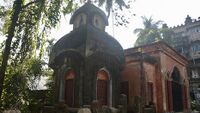
यह मंदिर ऊना के बाहिया गांव में स्थित है। किंवदंती है कि पांडवों के परिवार के पुजारी का नाम धयूनसार था जिनका ज्रिक महाभारत में किया गया है। वह पुजारी भगवान शिव के भक्त थे। भगवान शिव ने उनसे प्रसन्न होकर उनको वरदान किया कि अगर कोई भक्त इस मंदिर में सच्चे मन से कुछ मांगेगा तो उसकी सारी मनोकामनांए पूरी हो जाएंगी। पहले इस मंदिर को धयूनसारेश्वर सदाशिव तीर्थ के नाम से जाना जाता था। बाद में इसे धयूनसार महादेव मंदिर कहा जाने लगा। आज से लगभग 50 साल पहले इस मंदिर को स्वामी आंनद गिरि ने पुनर्निर्मित करवाया था। यह स्वामी उत्तरकाशी के एक महान संत थे। शिवरात्रि के दौरान इस मंदिर में श्रद्धालुओं की भारी संख्या दर्शन करने के लिए आती है। भगवान की मूर्ति पर दूध और दही चढ़ाया जाता है। [7]
Notable persons
- Bedi Sujan Singh of Una - List of Punjab Chiefs
- स्व. अर्जुन सिंह - न्यायपालिका में ऊना निवासी स्व. अर्जुन सिंह बड़ा नाम हैं।
- मोनिका सोमल न्यायपालिका में हैं।
- सोमल आईएफएस आफसर रहे हैं।
- Brig. Surjit Singh - ब्रिगेडियर सुरजीत सिंह (ऊना
Temples
Chintpurni and Baba Balak Nath are the temples most visited by Hindus and Sikhs.
Bhadurkali Mata Mandir, Guga Jahar Peer, Bhadurkali; Dera Baba Barbhag Singh MAIRI; Dera Baba Rudru; Radhe Krishna Mandir, founded by Baba Bal, Kotla Kalan; Baba Moni temple, Ghanari; Jogi Panga: Dharamshala Mahanta; Dhunsar Mahadev Temple, Talmehra; Pir Nigaha, Madanpur Basoli; Shivbari Temple, Gagret; Dmamiya, Ispur, Suhin Guga, Lohara Mandir are some other popular temples.
Brahmahooti, situated near Mehatpur, is one of the two temples in India dedicated to God Brahma, the other being in Pushkar, Rajasthan. Though less known, this temple is situated close to a serene lake in the laps of hills.
External links
References
- ↑ दिव्य हिमाचल
- ↑ A glossary of the Tribes and Castes of the Punjab and North-West Frontier Province By H.A. Rose Vol II/D, p.243-44
- ↑ https://hpuna.nic.in/hi/
- ↑ https://hpuna.nic.in/hi/
- ↑ https://hpuna.nic.in/hi/
- ↑ https://hindi.nativeplanet.com/una/attractions/kutlehar-forts/#overview
- ↑ https://hindi.nativeplanet.com/una/attractions/dhyunsar-mahadev-temple/#overview

